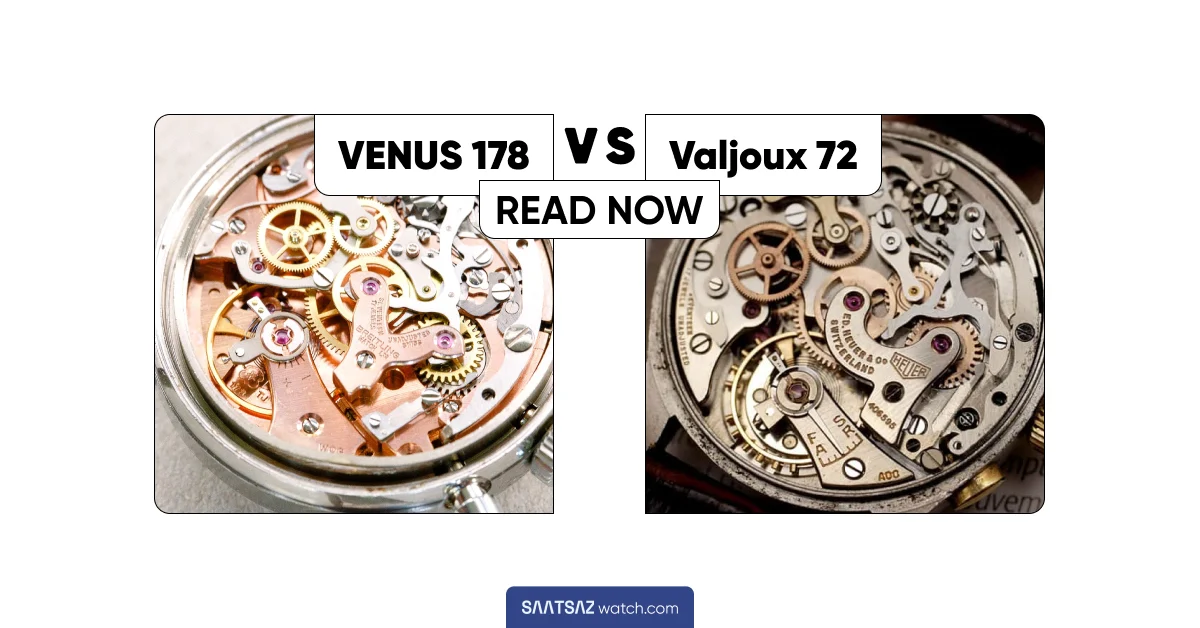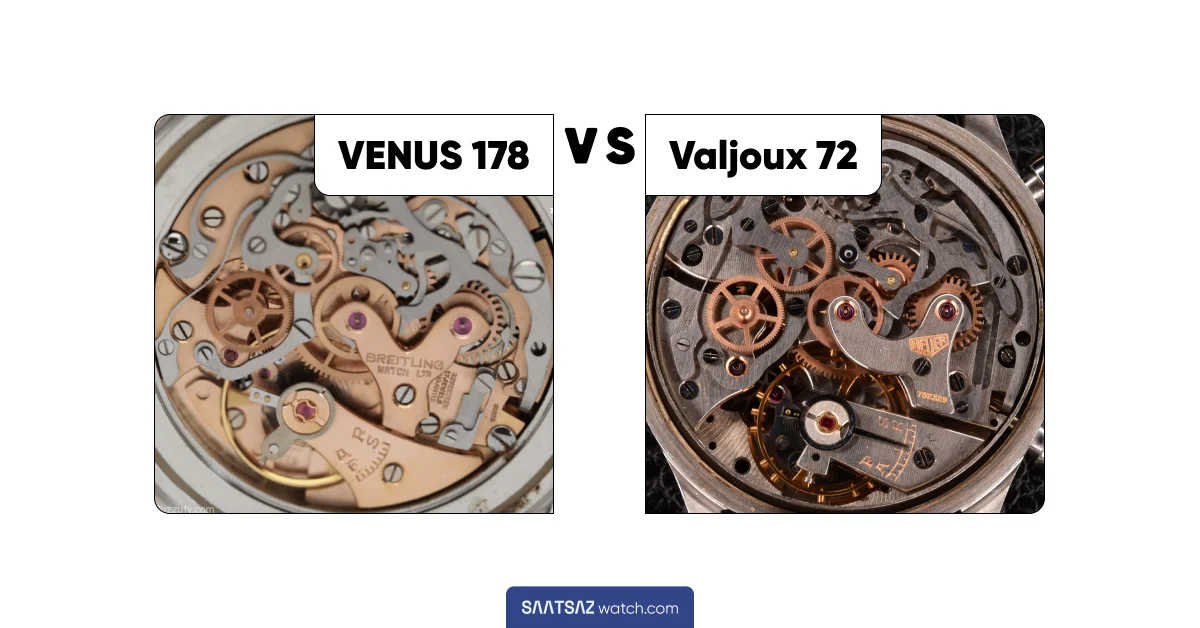Venus 178 vs Valjoux 72 – Chronograph Movements Comparison

In the realm of vintage watches, few movements stir the heart of an enthusiast like the Venus 178 and the Valjoux 72. Both have etched their names in the annals of horological history, powering some of the most iconic timepieces of the 20th century. But how do Venus 178 vs Valijoux 72 chronograph movements compare? Stay with us at Saatsaz Watch and let’s get to these watch chronograph movements comparison.
Table of Contents
Venus 178 vs Valjoux 72 comparison
The Venus 178 is a well-regarded manual-wind column-wheel chronograph movement that has been used in a variety of watch models over the years. Meanwhile, the Valjoux 72 is one of the most iconic and revered manual-wind chronograph movements in the history of watchmaking. How do these chrono movements compare in different aspects?
Historical Footprints
- Venus 178: Originating from the Swiss company Venus, this manual-wind column-wheel chronograph movement found its way into watches primarily in the mid-20th century. The Venus 178 is perhaps most famously associated with Breitling’s Navitimer watches from the 1950s and 1960s.
- Valjoux 72: Introduced in the early 1930s, the Valjoux 72 saw production until the 1970s, marking it as one of the most extensively produced chronograph movements. Its claim to fame is its association with the early versions of the Rolex Daytona.
Technical Mastery
- Venus 178: Renowned for its column-wheel mechanism, the Venus 178 exemplifies traditional watchmaking craftsmanship. The column-wheel ensures accurate and smooth actuation of the chronograph’s start, stop, and reset functions.
- Valjoux 72: A manual-wind, column-wheel chronograph with three registers, the Valjoux 72 operates at 18,000 beats per hour. Over the years, it inspired several variants, like the 72C with a calendar function and the 88 with a moon phase.
Iconic Associations
- Venus 178: The Breitling Navitimer, an emblematic pilot’s watch, houses the Venus 178. This association with an iconic piece elevates the movement’s stature among collectors and aficionados.
- Valjoux 72: Beyond the Rolex Daytona, the Valjoux 72 found its way into various other notable timepieces, cementing its legacy in the watchmaking industry.
Collectibility and Legacy
While both movements are highly collectible and sought after in the vintage watch market, their legacies are somewhat different. The Venus 178, with its close association with the Navitimer, represents a particular segment of aviation history. On the other hand, the Valjoux 72, given its broader usage, paints a more expansive picture of 20th-century watchmaking.
In summary, comparing the Venus 178 and the Valjoux 72 is a journey through time, appreciating the intricacies of vintage chronograph movements. Each has its distinct charm, technical brilliance, and historical significance. While some may debate over preferences, one thing is clear: both the Venus 178 and Valjoux 72 stand as titans in the world of horology.

Now that we are here, there is another famous chrono movement models from these brands that we want to compare to help you get a better idea. The Venus 188 vs Valjoux 7730. But this time we’ll keep it short and stick to their pros and cons.
What is the difference between Venus 188 and Valjoux 7730?
The Venus 188 and the Valjoux 7730 are chronograph movements with intertwined histories. Here’s a compact list outlining their differences:
Venus 188 Pros and Cons
Pros:
- Original Design: The Venus 188 was developed as a distinct movement, showcasing the innovative capabilities of the Venus company.
- Collectibility: Given its limited production timeline, watches with the Venus 188 might be rarer, thus potentially more sought after by certain collectors.
Cons:
- Shorter Production Run: This could mean limited availability of replacement parts or specific expertise for repairs.
Valjoux 7730 Pros and Cons
Pros:
- Foundational: The 7730 laid the groundwork for the subsequent and popular 773X series movements.
- Greater Distribution: Benefited from Valjoux’s expansive distribution network, leading to its presence in a wider variety of watch models.
Cons:
- Derivative Nature: Essentially a rebranded and slightly modified Venus 188, it might lack the “originality” factor for some purists.
To summarize, in essence, the transition from the Venus 188 to the Valjoux 7730 represents a pivotal moment in watchmaking history, marking a bridge between two iconic names in chronograph movement production.
Conclusion
Venus and Valjoux stand as monumental pillars in the chronograph universe. While Venus set the stage with its innovative designs, Valjoux expanded upon this legacy, reaching a broader audience. Their combined histories not only highlight the technical evolution of watchmaking but also underscore the enduring allure of chronographs. In the end, both brands have left an indelible mark, captivating watch enthusiasts across generations.
FAQ
How big is the Valjoux 72?
- The Valjoux 72 is a manual-wind chronograph movement with a diameter of approximately 29.5mm.
What is the difference between Valjoux 72 and 92?
- Both the Valjoux 72 and 92 are manual-wind chronograph movements. The primary difference is in their configuration. The Valjoux 72 features three registers (hours, minutes, and continuous seconds), while the Valjoux 92 is a two-register movement with minutes and continuous seconds.
What is the Valjoux based movement?
- A “Valjoux-based movement” refers to a watch movement that is either directly produced by Valjoux or is a derivative, built upon the design or architecture of an original Valjoux movement.
Is the Valjoux 7750 a good movement?
- Yes, the Valjoux 7750 is widely considered a reliable and robust automatic chronograph movement. Its design and efficiency have made it one of the most popular and widely-used chronograph movements in the watch industry.
Does Rolex use Valjoux movement?
- Historically, Rolex did utilize Valjoux movements, most notably the Valjoux 72 in early versions of the Rolex Daytona. However, Rolex transitioned to using in-house movements, and modern Rolex watches are equipped with Rolex’s proprietary calibers.



